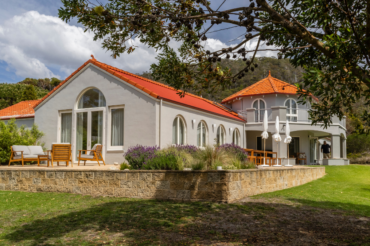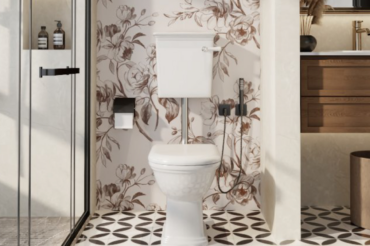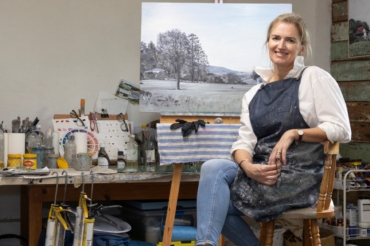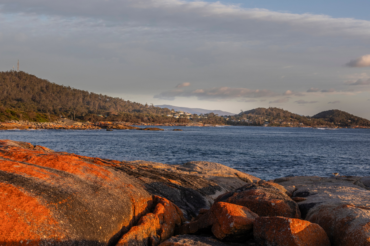
In the past, Bathurst and its surrounding villages may have been eclipsed by the neighbouring towns of Orange and Mudgee. However, as a recent visit shows, now is the historic city’s time to shine once more.
Xanthe Morgan has 40 paying guests coming for dinner but she appears totally undaunted by the task ahead of her. “It’s just simple country fare,” she says. “Pumpkin soup with croutons, roast been f fillet with vegies and a cake for dessert.” Besides, she adds, she has help, with a nod to her husband, Chris, who is busy dressing the tables in the ballroom while chatting to guests who are taking a self-guided tour of Abercrombie House, and a neighbour who is currently manning the coffee cart, but will later help with the service.

The historic home on the outskirts of Bathurst has belonged to the Morgan family since 1969, when Chris’s parents bought it and started a restoration program that has been continuing ever since. Built in the 1870s by Bathurst district pastoral pioneers, the Stewart family, the property has four main attractions, according to Chris. “It’s a working home,” he says. “We actually live here and as you walk around, you’ll see the cat sleeping on the bed, or the books we are currently reading lying about. It’s also Scottish to the core — the first truly Scottish baronial manor house in Australia and we celebrate that to the max.
Fortunately, I have Scottish history, so I can put on a kilt and address the haggis and not feel like I’m faking it. It also enjoys every possible heritage listing you can have in this country and people in this community feel a strong connection to the property. We host birthday parties, special events, even weddings here, and our high teas are usually booked out well in advance.”
Located 200 kilometres north-west of Sydney in Wiradjuri country, Bathurst was established in 1815, making it Australia’s oldest inland European settlement. Its first golden age began in 1851, when Edward Hargreaves found gold at nearby Orphir and a rush began. Then, in 1872, Hill End prospector Bernhard Holtermann found the world’s largest specimen of reef gold, a 286kg “nugget” that was almost as tall as the man himself, and the find ensured the goldrush continued to the end of the decade. These days, Hill End is an appealing weekend destination much favoured by artists who have come to retreat there for decades, explore the historic buildings as well as enjoy the chance to still strike it lucky when panning for gold in the river bed.

On the other side of Bathurst at the Bathurst Grange Distillery, Toby and Sue Jones also claim connection to the gold-rush days as Toby’s ancestors established the Royal Hotel in Sofala and the Club House Hotel in Hill End, to satisfy thirsty miners during the 1860s. Their association with the Grange began in 1962, when Toby’s great-aunt Freda bought the property, which was part of a land grant from 1823, and its homestead, believed to be Australia’s oldest surviving farm dwelling, dating to 1830.
Toby’s first life was in marketing for the pharmaceutical industry, but when he and Sue returned after a decade overseas in 2014, and were casting around for a new direction, their son Nick suggested a whisky distillery. So the family took a trip to Tasmania, where they learnt all they could from from the “godfather of Australian whisky”, Bill Lark, then moved to Bathurst Grange to pursue their dream. They run sheep and use the spent whisky grain to feed the livestock as well as recycle water and use solar power to make their enterprise as sustainable as possible. The end game at Bathurst Grange may be whisky but, at the moment, it’s all about gin, thanks to a relic of legislation from WWI, which stipulated that whisky must be barrel-aged for at least three years before it can be sold.
The Jones’s whisky is tantalisingly maturing in barrels behind the tasting room in the former farm shed they have converted to house their stills. In the meantime, tasters can console themselves with some mighty fine gins, some infused with botanicals picked from the property’s own garden. There’s a Rose Garden gin and a mint- and rosemary-infused Blue Mountain gin, which turns purple when you add tonic water. But the one everyone talks about is the Chilli Chocolate gin, which we can vouch turns into a splendidly alcoholic jaffa hit when mixed with Fentimans Valencian Orange tonic water.

Australian Country was tipped off about Bathurst Grange by the hosts of the Red Hill Nest, a B&B established by Dan and Annika Collins in a remodelled chook shed on their 100-acre (40-hectare) farm, which is also home to their Murray Grey stud. Annika is a paediatric nurse by day and Dan was a chef before they moved to the country in search of a better work-life balance and a healthier life for their two kids. They’re typical of the new wave of energy that’s washing across the Bathurst Plains, full of enthusiasm for their new home and its myriad attractions. Their two-bedroom guest cottage is self-catering, but there’s a breakfast hamper laden with eggs from the (now) rehoused chooks, home-grown tomatoes and freshly baked sourdough from Bathurst’s Bootleg Bakery.
Dan and Annika also joined the chorus of recommendations to check out the pub at Rockley, which has recently been taken over by stellar chef and TV personality Matt Moran. Matt has long connections with the district as his family farm is nearby and he has harboured notions of giving the pub a new lease on life for a while now. He has big plans to add accommodation options to the town but, for the time being, visitors are lapping up the revamped menu, which includes all the pub classics, but with the Moran magic — the schnitty is Parmesan-crumbed by someone who knows what to do with an egg wash, the chips are hand-cut and the pickled vegies and egg on the farmer’s plate are made in-house. A quick post-prandial stroll around the village unearths the Olive Robin, the kind of homewares shop you hope to come across, but rarely do, with an intriguing mix of locally made and appealing gift items ranging from macramé plant hangers to cookbooks by the celebrity chef himself.

There’s energy too at Oberon, gateway town to the famous Jenolan Caves with its limestone formations, a reputation as a trout-fishing haven and a mecca for mushroom foragers in autumn. Fortified by a locally sourced snack from the farm belonging to the owners of the Long Arm Cafe, we’re met at the tourist info centre by tour guide Ian Redpath, of Detour Adventures, who takes the risk out of picking mushrooms from the wild with his expert knowledge of the “right” ones to harvest from the pine forests surrounding the town. As well as mushroom tours, Ian takes visitors to the region’s more remote and rugged destinations in the national parks and other hard-to-get-to spots and will happily tailor trips for special interests. Oberon is also home to Lowes Mount Truffière where, during the winter months, aficionados of the fragrant fungus can join a truffle hunt followed by lunch.
Laden with slippery Jack and saffron milk cap mushrooms, we retire to our home for the night, the splendidly appointed, two-bedroom Hickory Moon B&B, where the kitchen has everything we need to turn the day’s harvest into a feast.

The adventure continues the next morning with a visit to Mayfield Gardens, a 185-acre (75-hectare) showcase of good planning and plantsmanship, which lays claim as the largest privately owned cool-climate garden in the Southern Hemisphere. Bathed in late-autumn colour, it’s a testament to the vision of merchant banker Garrick Hawkins and designer Peter D’Arcy and needs a full day to properly explore the water garden and bluestone bridge, the grotto, the pond with its obelisk and allée of plane trees, a valley with five ponds and a sandstone gallery. If you time your visit well, you can explore the Hawkins family’s private areas, which are open for two weeks each season and include a chapel and maze, a stumpery, a Hilton for chickens and more gob-smacking garden rooms. Be sure to leave time to sample the menu at the cafe, which features just-picked produce from the kitchen garden.
The cobblestone-lined streets of Millthorpe have long enjoyed tourist patronage, due in no small part to the existence of Tonic, a beacon on the Central West’s culinary map established by Tony and Nicole Worland in 2003. A five-course set menu is a tasting tour of the region’s produce and there’s an option of local wines by the glass. Just as well that our rooms were a short stroll away at the Millthorpe Boutique Motel, a significant cut above the average in space, amenity and style. The Slow Wine Co HQ is right next door and father and daughter duo Terry and Jen Johnson welcome visitors for tastings of their cool-climate wines. Patrons can add in a tapas menu on Friday and Saturday nights. Millthorpe is a shopper’s paradise, and a trawl through the boutiques in the main street is bound to impact the credit card. The Trader’s Caravan is a delightful case in point, brimming with ethical jewellery and accessories from all points of the globe.

Visit in spring for the Millthorpe Garden Ramble through local gardens, just one of a calendar of events to add interest to a trip. Bathurst hosts a Shakespeare Festival in November, a Winter Festival in July, a Heritage Trades Trail in April and, of course, it would be remiss not to mention the Bathurst 1000 in October, a 1000-kilometre endurance event on Mount Panorama that attracts motor sport enthusiast from all over Australia. During two weekends in September, residents of the village of Rydal open their gardens for the enjoyment of, quite literally, hosts of golden daffodils.
Staying at Bishop’s Court Estate, the luxuriously appointed home of the first Anglican Bishop of Bathurst, is a good introduction to the city’s other gracious buildings, which include the neoclassical courthouse and the War Memorial Carillon on Kings Parade. The Bathurst Regional Art Gallery or BRAG as it is affectionately known, is a benchmark regional space, while train buffs won’t want to miss the newly revamped Railway Museum.
For decades, the hospitality providers of the nearby wine-producing regions of Orange and Mudgee have enjoyed a reputation as THE destinations for travellers with a taste for the finer things in life. However, after a few days in Bathurst, Central NSW it’s abundantly clear that there’s a new contender for consideration. Because the hosts are just beginning to enjoy emerging status, the welcome feels a bit more heartfelt and the willingness to share the region’s many attractions couldn’t be more enthusiastic.
For more information, go to visitcentralnsw.com.au.
Photography Ken Brass & Destination NSW









